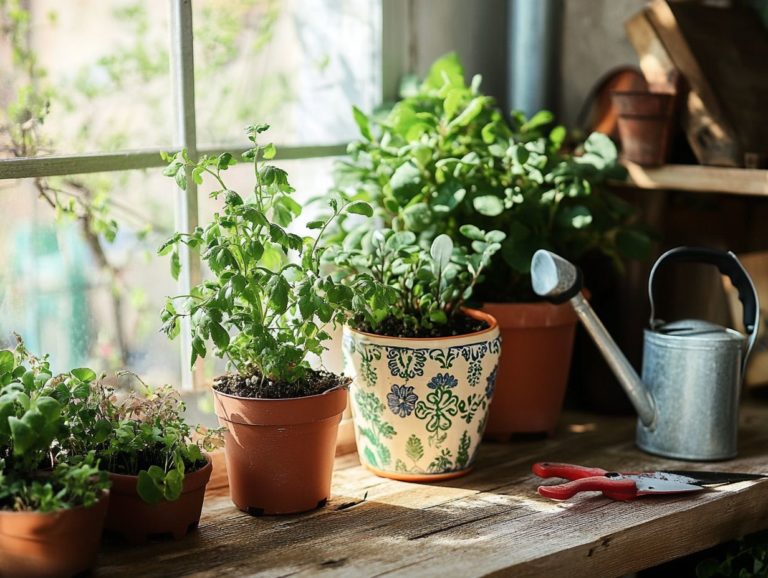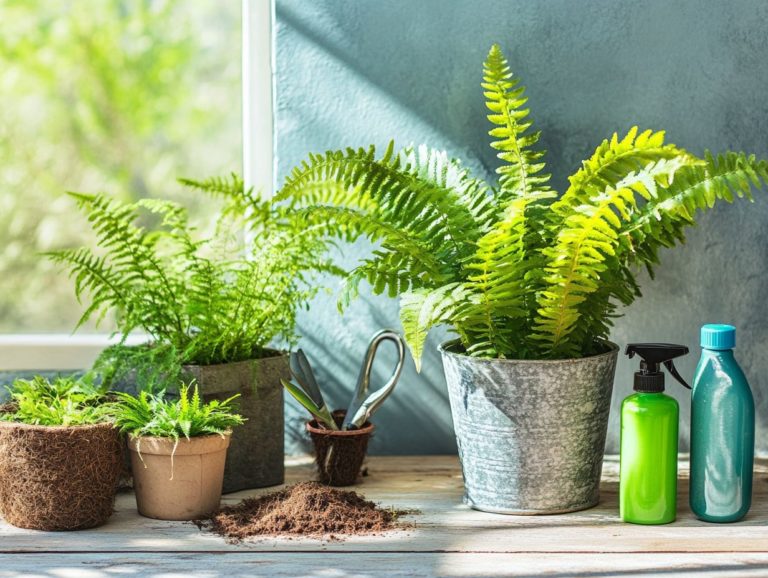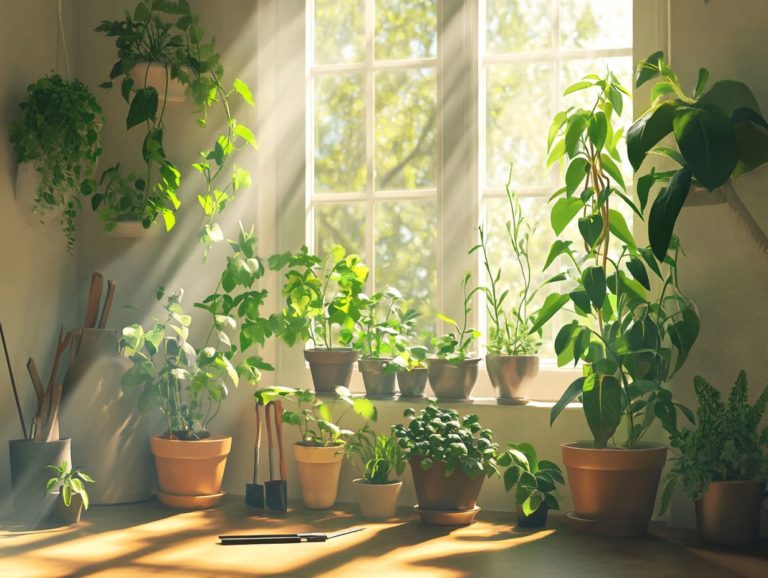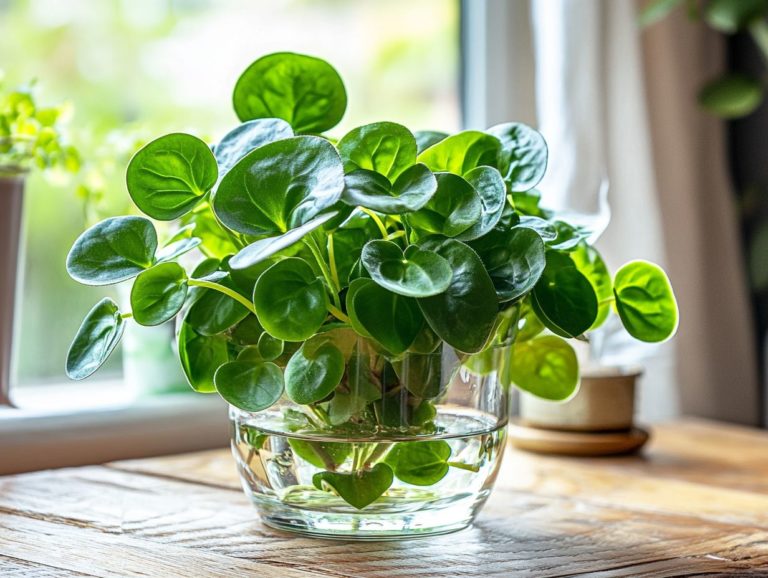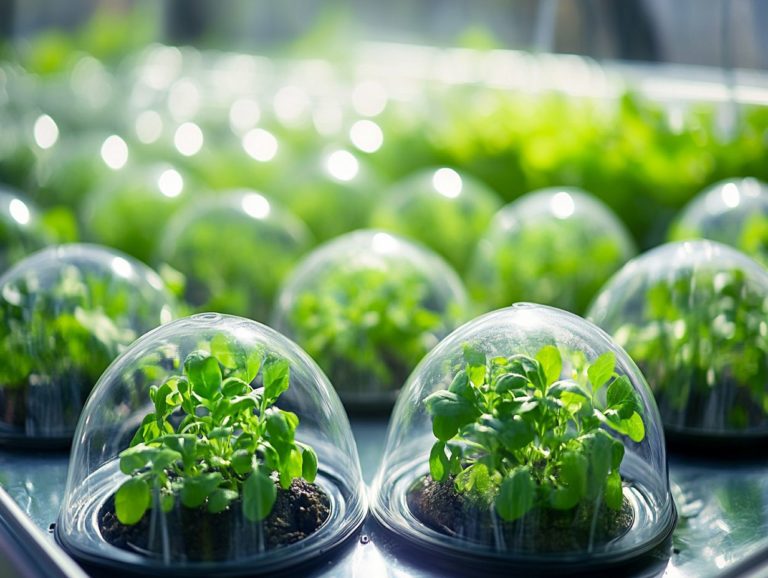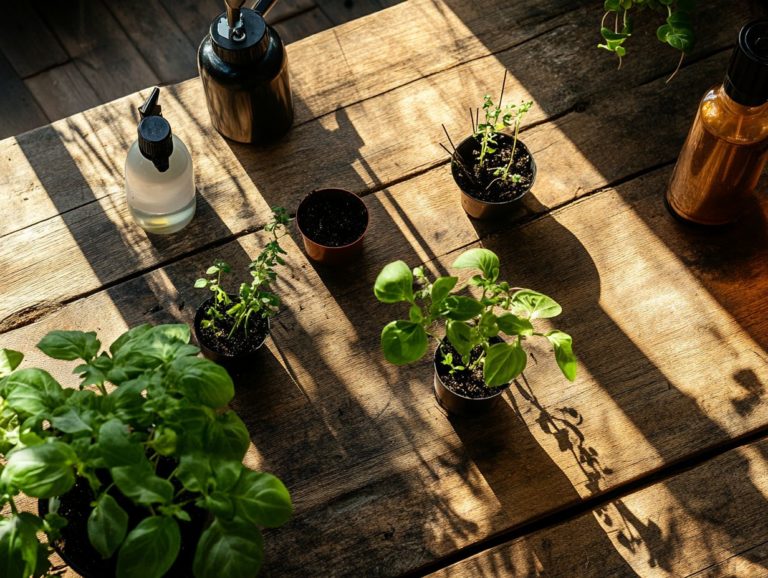The Top 7 Mistakes in Indoor Plant Propagation
Indoor plant propagation can be a truly rewarding endeavor, but it’s all too easy to stumble into mistakes that might undermine your success.
From selecting the wrong soil mix to overlooking pest control, grasping these common pitfalls is essential for every plant enthusiast.
Here, you ll delve into the top seven mistakes that many make when propagating indoor plants, all while exploring the ideal conditions and effective methods to overcome them.
Whether you re just starting out or you ve been cultivating plants for years, these insights are designed to help your plants flourish. Discover how to refine your propagation skills and create a vibrant indoor garden that brings joy and life to your space!
Contents
- Key Takeaways:
- 1. Using the Wrong Soil Mixture
- 2. Overwatering or Underwatering
- 3. Not Providing Enough Light
- 4. Not Controlling Temperature and Humidity
- 5. Not Pruning or Trimming Properly
- 6. Not Using the Right Propagation Method
- 7. Not Monitoring for Pests and Diseases
- What Is Indoor Plant Propagation and Why Is It Important?
- What Are the Different Methods of Indoor Plant Propagation?
- What Are the Ideal Conditions for Successful Indoor Plant Propagation?
- How Can One Identify and Treat Pests and Diseases in Indoor Plants?
- What Are the Common Mistakes to Avoid When Propagating Indoor Plants?
- What Are Some Tips for Beginners in Indoor Plant Propagation?
- How Can Indoor Plant Propagation Benefit the Environment?
- What Are Some Common Misconceptions About Indoor Plant Propagation?
- Frequently Asked Questions
Key Takeaways:
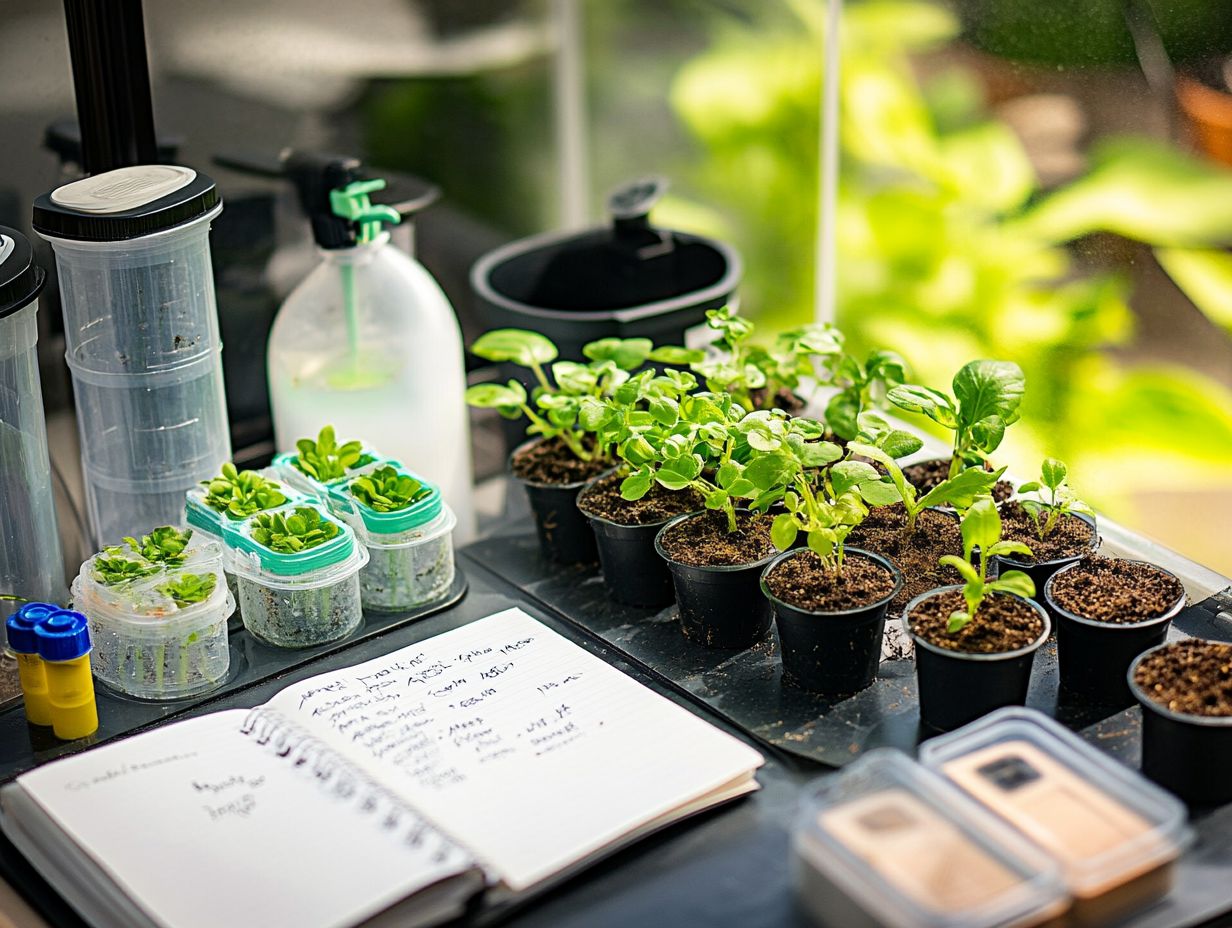
- Using the right soil mixture is crucial for successful indoor plant propagation. Avoid using regular garden soil and opt for a well-draining mix specifically designed for indoor plants.
- Proper watering is key. Avoid over or underwatering your plants. Check the soil moisture before watering and adjust based on the specific needs of each plant.
- Indoor plants need adequate light to thrive. Make sure to provide enough natural or artificial light for your plants and rotate them regularly to prevent uneven growth.
1. Using the Wrong Soil Mixture
Using the wrong soil mixture can be detrimental to the health of your houseplants. It may lead to issues like poor drainage, inadequate nutrient supply, and ultimately, plant stress, which can jeopardize your propagation efforts.
Selecting the right soil mix is essential for meeting the specific needs of different houseplant species. For example, succulents thrive in a gritty, well-draining mix, while ferns prefer a sponge-like substrate that retains moisture.
Experts like Jason Croutch recommend incorporating organic matter to boost nutrients. Claire Akin highlights that perlite is a lightweight material that helps with drainage, while vermiculite retains moisture, enhancing aeration and root health.
Knowing what each plant needs can transform your gardening experience and lead to lush, vibrant growth! Your decisions about soil composition can significantly influence the vitality of your houseplants.
2. Overwatering or Underwatering
Overwatering or underwatering your houseplants can spell trouble, leading to unhealthy growth, root issues, and propagation mistakes that could derail your gardening ambitions.
It s vital for you to recognize the signs of each condition to ensure your green companions flourish. For instance, if your plants are overwatered, you might notice yellowing leaves, a wilting appearance despite soggy soil, and even an unpleasant musty smell that hints at root rot. On the flip side, underwatered plants tend to show dry, crispy leaves and may droop even when the soil appears somewhat moist.
To find that perfect moisture balance, pay close attention to the light conditions your plants enjoy; brighter spaces usually mean they ll need more frequent watering. Temperature and humidity levels also influence how much water your plants need, so adjusting your watering schedule with the changing seasons is essential for fostering healthy growth.
3. Not Providing Enough Light
Not providing enough light can significantly impact the health of your indoor plants, leading to stunted growth and propagation failures that can test the patience of even the most dedicated gardeners.
Each plant species comes with its own set of light requirements. For example, vining plants like pothos thrive in bright, indirect light, while fiddle leaf figs demand ample brightness to truly flourish. Understanding these unique needs is essential to ensuring your plants receive the right amount of light.
Utilizing sheer curtains can diffuse harsh sunlight while still providing necessary exposure, and rotating pots periodically allows all sides of the plant to bask in the light evenly.
Regularly assessing your plants will also help you identify if any adjustments are needed, fostering successful growth and propagation. This attentive care ultimately enriches your indoor gardening experience, turning it into a rewarding endeavor.
Act now to prevent these common propagation pitfalls! Avoiding these top mistakes in watering indoor plants will lead you to a flourishing indoor garden.
4. Not Controlling Temperature and Humidity
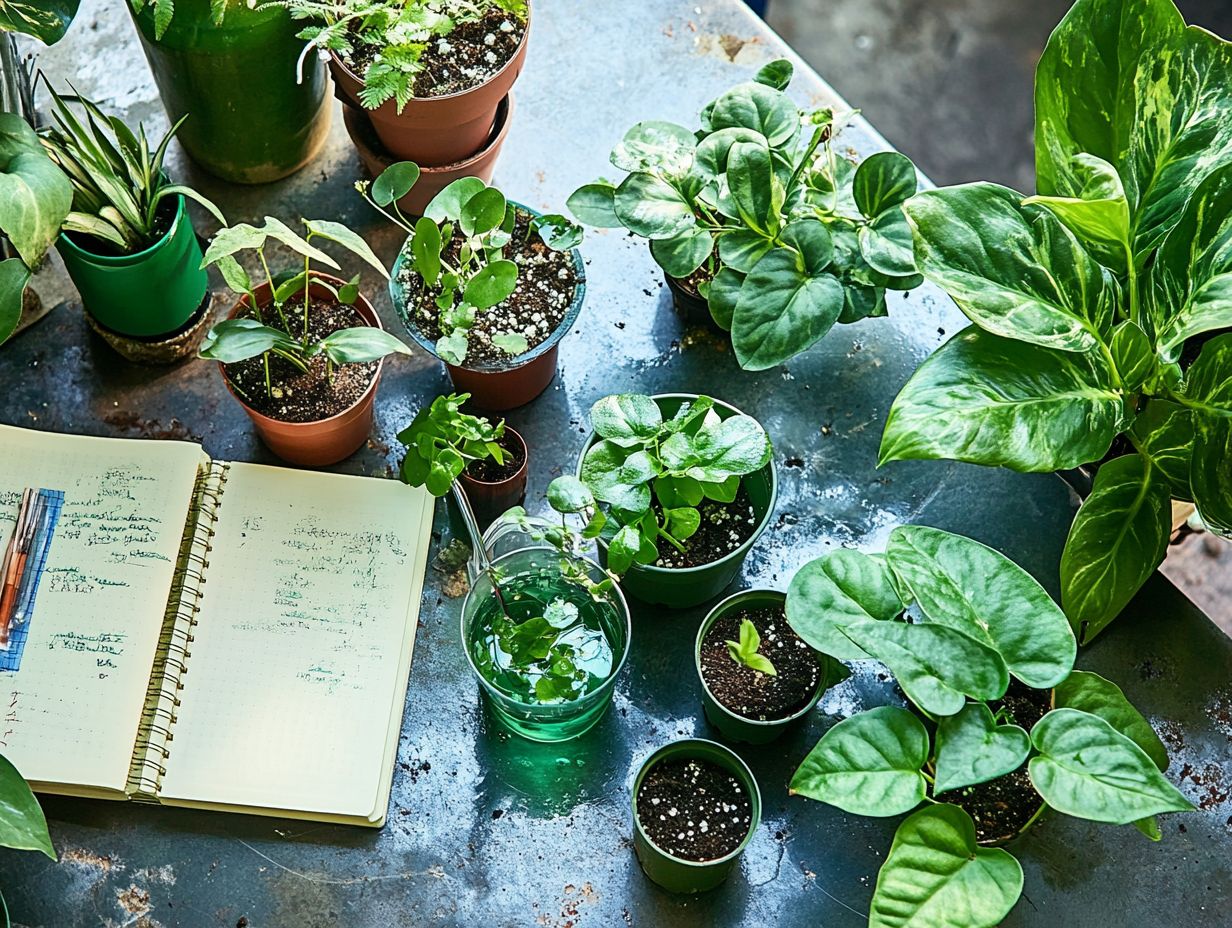
Neglecting to manage temperature and humidity levels in your indoor gardening space can create an unwelcoming environment for your houseplants. This neglect leads to stunted growth and heightened stress levels.
Take the ZZ plant, for instance. It flourishes in temperatures between 65 F and 75 F (18 C to 24 C) and thrives in moderate humidity levels of around 40-60%. To create such an atmosphere, consider positioning your plants near a humidifier or using pebble trays filled with water to boost moisture.
Keep a trustworthy thermometer on hand to monitor indoor temperatures, making necessary adjustments. This ensures your plants are shielded from drafts and extreme heat.
Maintain optimal conditions to help both succulents and tropical varieties thrive. This paves the way for successful plant reproduction and long-lasting vitality.
5. Not Pruning or Trimming Properly
Improper pruning or trimming techniques can lead to unhealthy cuttings and propagation errors. This ultimately impacts the overall maintenance and aesthetic appeal of your indoor plants.
Follow best practices in pruning. Focus on cutting just above a leaf node the part of the stem where leaves grow since this is where new growth is most likely to sprout. Claire Akin, a respected horticulturist, underscores the importance of using sharp, clean tools like pruning shears to minimize damage. Remember to disinfect these tools before and after each use to prevent disease spread.
For a smooth experience, it’s advisable to prune during the plant’s active growing season, ideally in spring. This timing allows for rapid recovery and an abundance of foliage, transforming your indoor garden into a thriving oasis.
6. Not Using the Right Propagation Method
Using the wrong propagation method can spell disaster for your cuttings. It hinders your efforts to cultivate healthy specimens and expand your houseplant collection.
It’s crucial to understand that different plant species thrive under varied conditions and respond to distinct plant reproduction techniques. For example, some plants might thrive with water propagation, allowing their roots to develop before making the leap into soil, while others may prefer being propagated directly in a moisture-retentive medium.
Grasp the unique characteristics of your plants such as their growth habits and seasonal cycles to refine your decision-making process. By assessing these factors, you can pinpoint the most effective rooting method, greatly enhancing the success rate of every cutting.
7. Not Monitoring for Pests and Diseases
Neglecting to keep an eye out for pests and diseases puts your indoor plants health and your propagation efforts at risk.
Without regular checks, common nuisances like spider mites, aphids, and powdery mildew can quickly take over. You might notice signs of these pests appearing as discolored leaves, webbing, or even a sticky residue on your plant s surfaces. This underscores the importance of prompt action.
Act quickly when you spot pests to protect your indoor garden. You can turn to insecticidal soap or neem oil, ensuring thorough application to all affected areas.
A clean environment is key to keeping your plants happy and healthy! By removing dead leaves, dusting foliage regularly, and ensuring pots have proper drainage, you can significantly diminish the chances of these pests thriving.
By incorporating these practices, you can cultivate a healthier indoor oasis that thrives in your care.
What Is Indoor Plant Propagation and Why Is It Important?

Indoor plant propagation is the art of creating new plants from seeds, cuttings, or other parts. It s a valuable skill for anyone looking to expand their collection and nurture healthy specimens.
By mastering techniques like division, layering, and leaf propagation, you ll deepen your appreciation for plant biology and strengthen your connection to your green companions. This practice not only helps you create a diverse indoor sanctuary but also promotes sustainable gardening by reducing the need for store-bought plants.
As you explore propagation, you ll join a vibrant community that shares tips, experiences, and even plant swaps. This enriches your gardening journey, whether you re just starting out or have been nurturing plants for years.
What Are the Different Methods of Indoor Plant Propagation?
There are several effective methods for indoor plant propagation, including cuttings, division, and layering. Each method is suited to different plant species and growth stages.
Understanding these techniques will help you maintain healthy, vibrant specimens. For cuttings, choose healthy segments look for stems free from disease with at least one node for optimal growth.
For example, softwood cuttings work well for fast-growing plants like pothos, while semi-hardwood cuttings are suitable for shrubs. Division involves carefully separating roots from mature plants, often with a sharp tool to minimize damage.
Layering may take a little longer but can be very rewarding, especially for vining plants. This technique involves burying part of the stem in soil to promote root development while keeping it attached to the parent plant.
When done with care, these techniques can lead to thriving houseplants that will enhance your indoor garden experience.
What Are the Ideal Conditions for Successful Indoor Plant Propagation?
Successful indoor plant propagation requires creating the perfect conditions for your plants. This means paying attention to light levels, temperature, and humidity, tailored to each plant species.
Finding the right balance among these factors encourages robust root development and improves plant health. Some species thrive in bright, indirect sunlight, while others prefer shadier spots. Temperature is also crucial; most plants enjoy warm environments to encourage growth.
Don’t overlook humidity! Higher humidity levels often lead to stronger root systems. By understanding how these elements work together, you can recreate natural conditions, increasing your chances of success and nurturing a lush indoor garden.
How Can One Identify and Treat Pests and Diseases in Indoor Plants?
Identifying and treating pests and diseases in your indoor plants is vital for their health and successful growth.
Watch for signs of infestations, such as wilting leaves, discolored patches, or visible insects like aphids and spider mites. A closer look may reveal sticky residue or fine webs, clear indicators of these unwelcome visitors.
Act quickly to save your plants! Using organic insecticidal soaps or neem oil can effectively eliminate pests. Ensure good air circulation and avoid overwatering to help prevent fungal diseases.
For long-term vitality, regularly inspect your plants and keep their environment clean. By embracing these preventative strategies, you can foster vibrant growth and significantly reduce the chances of future infestations.
Start your propagation journey today and explore exciting communities for plant lovers to share tips and experiences!
What Are the Common Mistakes to Avoid When Propagating Indoor Plants?

Avoiding common mistakes in indoor plant propagation is key to your success. Healthy specimens will flourish under your care.
Novice gardeners often overlook key aspects early in plant propagation. Using dirty tools can introduce harmful pathogens, jeopardizing entire batches of plants.
Choosing the wrong soil can hinder root development, making it difficult for new plants to thrive.
To sidestep these pitfalls, always sanitize your tools before diving in. Select good soil that lets water flow through easily, tailored to the specific needs of the species you re propagating.
By honing in on these details, you ll significantly enhance your chances of cultivating a thriving indoor garden!
What Are Some Tips for Beginners in Indoor Plant Propagation?
For those embarking on the journey of indoor plant propagation, a few essential tips can lay the groundwork for success.
Grasping the basics of plant propagation is crucial. Begin by selecting healthy parent plants, as their vitality impacts the success of their offspring.
Establish a perfect environment with adequate light, humidity, and temperature. A consistent atmosphere fosters robust root development.
Remember that keeping your tools clean is essential in preventing disease and promoting vigorous growth.
These simple strategies will help you quickly create a thriving indoor garden!
How Can Indoor Plant Propagation Benefit the Environment?
Indoor plant propagation not only enables you to expand your collection but also offers remarkable environmental advantages.
Nurturing new plants at home plays a crucial role in fostering a healthier ecosystem. Vibrant plants act as natural air purifiers, absorbing toxins and releasing oxygen.
Cultivating plant life contributes to local biodiversity by providing habitats for various species, encouraging a balanced ecosystem.
As your healthy plants thrive, they can inspire others in your community to adopt sustainable practices. This can spark collective efforts that promote environmental stewardship.
What Are Some Common Misconceptions About Indoor Plant Propagation?
Several misconceptions surround indoor plant propagation, often leading to confusion for novice gardeners.
You might believe that certain species are overly complicated to propagate, but with the right knowledge and techniques, you can successfully reproduce your favorite greenery.
It s easy to think that all houseplants require the same level of care. Overlooking the unique needs of each variety can result in stress or even the demise of your plants.
By shedding light on these myths and providing tailored guidelines, you can confidently embrace your journey into indoor gardening. Understanding the specific requirements of various plants will enhance your overall gardening experience.
Frequently Asked Questions
Start your indoor plant propagation journey today and watch your green oasis flourish!
What are the top 7 mistakes in indoor plant propagation?
1. Using low-quality soil: Poor soil can lead to bad drainage and fewer nutrients. This will harm your plants’ growth and care.
2. Overwatering: Too much water can cause root rot, which can kill your plants quickly.
3. Not providing enough light: Indoor plants need proper light to thrive. Without sufficient light, they can become weak and leggy.
4. Not repotting when necessary: As plants grow, they can outgrow their pots. This can lead to roots getting tangled and stunted growth.
5. Using the wrong fertilizer: Each plant has unique nutrient needs. Applying the wrong fertilizer can either starve the plant or burn its roots.
6. Neglecting to prune: Pruning encourages healthy growth and prevents overcrowding. It helps your plants flourish.
7. Not adjusting care with the seasons: Your plants’ needs change with the seasons. Failing to adjust watering and care can create serious problems.

